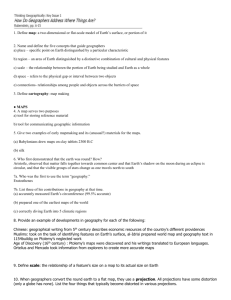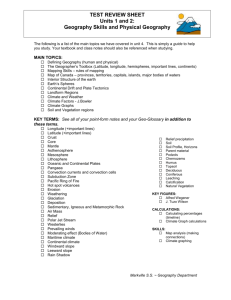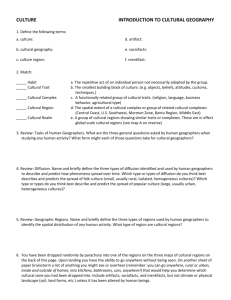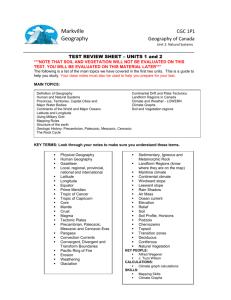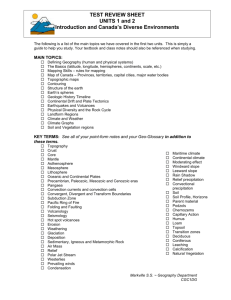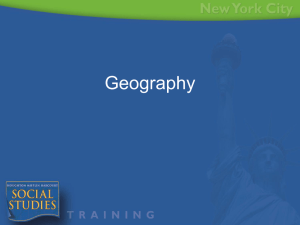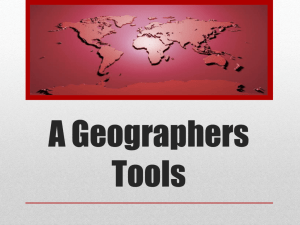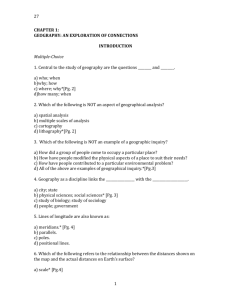Test One
advertisement
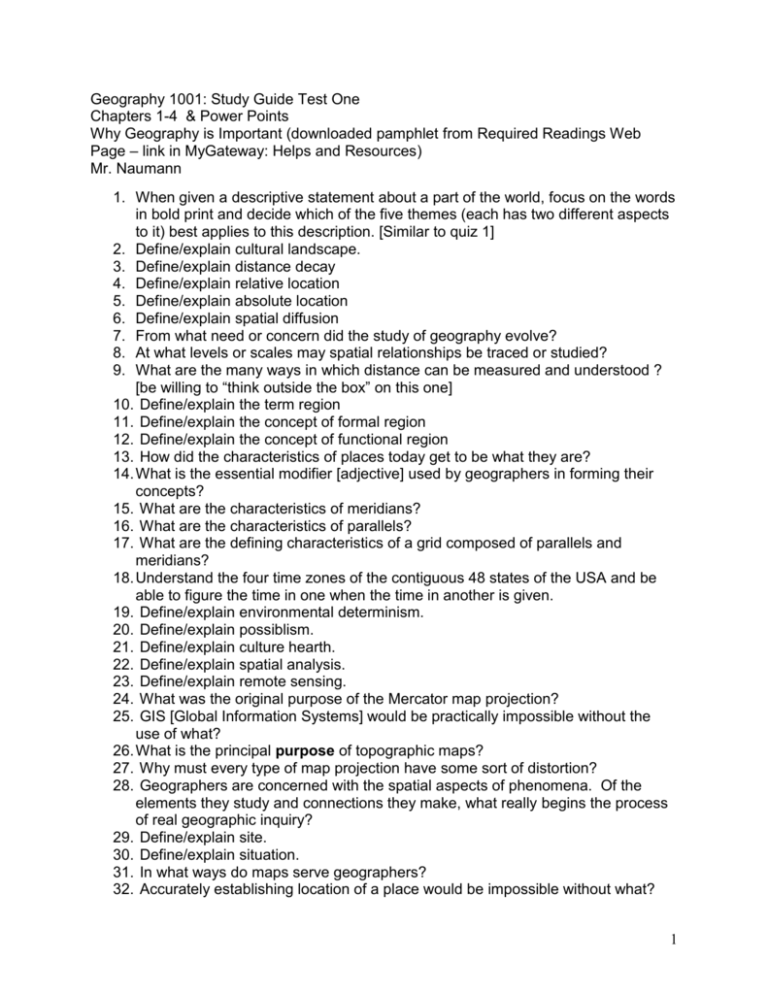
Geography 1001: Study Guide Test One Chapters 1-4 & Power Points Why Geography is Important (downloaded pamphlet from Required Readings Web Page – link in MyGateway: Helps and Resources) Mr. Naumann 1. When given a descriptive statement about a part of the world, focus on the words in bold print and decide which of the five themes (each has two different aspects to it) best applies to this description. [Similar to quiz 1] 2. Define/explain cultural landscape. 3. Define/explain distance decay 4. Define/explain relative location 5. Define/explain absolute location 6. Define/explain spatial diffusion 7. From what need or concern did the study of geography evolve? 8. At what levels or scales may spatial relationships be traced or studied? 9. What are the many ways in which distance can be measured and understood ? [be willing to “think outside the box” on this one] 10. Define/explain the term region 11. Define/explain the concept of formal region 12. Define/explain the concept of functional region 13. How did the characteristics of places today get to be what they are? 14. What is the essential modifier [adjective] used by geographers in forming their concepts? 15. What are the characteristics of meridians? 16. What are the characteristics of parallels? 17. What are the defining characteristics of a grid composed of parallels and meridians? 18. Understand the four time zones of the contiguous 48 states of the USA and be able to figure the time in one when the time in another is given. 19. Define/explain environmental determinism. 20. Define/explain possiblism. 21. Define/explain culture hearth. 22. Define/explain spatial analysis. 23. Define/explain remote sensing. 24. What was the original purpose of the Mercator map projection? 25. GIS [Global Information Systems] would be practically impossible without the use of what? 26. What is the principal purpose of topographic maps? 27. Why must every type of map projection have some sort of distortion? 28. Geographers are concerned with the spatial aspects of phenomena. Of the elements they study and connections they make, what really begins the process of real geographic inquiry? 29. Define/explain site. 30. Define/explain situation. 31. In what ways do maps serve geographers? 32. Accurately establishing location of a place would be impossible without what? 1 33. To accurately (at least relatively so) compare the area of some phenomenon in different parts of the world, which type of map projection one should use? 34. Maps that portray the surface of relatively small areas using contour lines are called what? 35. Upon what does the total amount of solar energy received (insolation) at a particular place on Earth depend? 36. The axis of rotation of the Earth is inclined how many degrees away from being perpendicular to the sun’s rays? 37. At which angle (of incidence) will the intensity of energy striking Earth be greatest? 38. Define/explain latent heat. 39. Most of the world’s deserts occur in what latitudinal zone? 40. The seasonal reversal of pressure and wind over a large continent, known as monsoon circulation, is characterized by what pattern or cycle? 41. When climbing a mountain, what would you predict about temperatures? 42. Which climate is influenced by the ITCZ (Intertropical Convergence Zone) most of the year? 43. The highest level of insolation received by the earth occurs between which latitudes? 44. A high pressure system over the land and a low pressure system over an adjacent water body results in what? 45. What is the generator of the wind belt system of the earth? 46. Northern Europe is warmer than one would expect from its latitude because of what influence? 47. What type is the most common kind of summer precipitation in St. Louis? 48. What type is the most common kind of winter precipitation in St. Louis? 49. Define/explain climate. 50. What earth-sun relationship exists at the equinoxes? 51. What is the lowest layer of the earth’s atmosphere? 52. Define/explain weather. 53. What kind of earth-sun relationship exists at the solstices? 54. Karst topography is found mainly in regions characterized by what geologic condition? 55. The opposite of a subduction or convergence zone between tectonic plates would be what type of zone? What are these features referred to as? 56. By what agent is loess deposited? 57. The earth’s crust is the outer, lighter portion of what? 58. Intrusive igneous rocks are formed below ground level by the hardening of what? 59. Where the North American & South American tectonic plates meet the Eurasian & African tectonic plates, the movement is described by what term or process? 60. What is the relationship between numbers on the Richter Scale for measuring earthquakes? 61. Gravity transfer is probably more active as an agent of gradation in what type of typography or landform? 62. Define/explain diastrophism. 2 63. Define/explain volcanism. 64. Define/explain faulting or a fault. 65. Define/explain tsunami. 66. Define/explain tectonic forces. 67. what conditions exist when a glacier appears to not be advancing? 68. How many periods of glaciation has the earth experienced? Where do the current glacial/temperature conditions of the earth seem to be in the scheme of glacial advances? 69. Which roles do streams play in shaping landforms? 70. Rock in the interior of Earth’s surface that carries slow moving convective currents is known as what? 71. The San Andreas Fault, where two plates slide past one another, is a famous example of what kind of plate boundary? 72. On most of Earth’s land surface what is the most important agent in moving weathered rock fragments downhill? 73. What kind of fans occur when sediment that the stream can no longer carry is deposited in a fan-shaped pattern? 74. Define/explain & describe soil creep. 75. What are the decomposers in the food chain? 76. Define/explain biosphere 77. Define/explain ecosystems. 78. Define/explain food chain. 79. Define/explain hydrosphere. 80. Define/explain desertification. 81. The Greenhouse Effect is related most closely to what environmental and human consequences? 82. In which region of the U.S. has acid rain the greatest potential for damage to surface water? 83. Aside from overhunting, the main cause of animal species extinction has been what? 84. Define/explain biomagnification. 85. What human actions/developments place growing demands on water supplies? 86. What would be the most likely effect of global warming? 87. Define/explain aquifer. 88. What is the source of energy that powers the hydrologic cycle? 89. What are the consequences of deforestation, particularly tropical rainforests? 90. What atmospheric element is absorbed by the biosphere during photosynthesis, stored in living organisms and in the soil, and released through respiration? 91. Define/explain soil (topsoil). 92. Terrestrial biomes reflect which two especially visible features? 93. If soil is bare or compact, how are the components of the hydrologic cycle affected? 94. Define/explain the process of plant succession. 95. Follow a drop of condensing water through the hydrologic cycle. 96. What roles do carbon & hydrogen play in the biosphere? 97. What factors determine soil properties (soil types)? 3 98. What areas have highly weathered soils that are low in fertility due to leaching and are usually oxidized? 99. Of the four spheres studied, whis is the one most important for linking the four together? 100. Explain the value or importance of each of the five requirements of a good map. 101. Explain this statement: Nature provides the foundation for human life and action; however, culture largely determines the parameters within which human actions occur. 102. Explain why geography has been called “The Mother of all Sciences.” 103. Explain the main differences between the environmental determinist and possibilist schools of thought. 104. Explain how the U.S. differs from all other countries in the world climatically and why this is to its advantage. 105. Explain at least three roles (effects) the oceans play in the ecosystem of the world.. 106. Explain the differences between weathering and erosion, and explain the two weathering processes 107. Explain and defend this statement using 3 examples: Natural conditions are rare or even non-existent in the world today. 108. Explain Barry Commoner’s four laws of ecology giving examples of each and showing why it is essential for citizens to understand these laws and value what they teach us. 109. Explain why introducing new species of plants or animals to and ecosystem may be a risky and detrimental action. Use three examples to support your explanation 110. The Earth is actually about 1 million miles closer to the sun in December than it is in June. What explains the warmer temperatures in the northern hemisphere in June as compared to December? Don’t just name it, explain why this happens. Study Guide Questions for Why Geography Is Important 1. Learning Geography can create what kind of citizens? Citizens able to understand and do something about some of the major issues and problems facing the US and the world. 2. What are some of the major issues facing the US and the world? Climate change, energy dependence, war & regional conflicts, globalization, and international terrorism 3. Why do Americans need to understand the nature of foreign cultures? (1) economic globalization and job mobility (2) people in foreign cultures represent both a labor force and a market for our products 4. Geographic knowledge can help what kinds of leaders among the states of the world? Political, diplomatic, military, and economic 4 5. How has the “information revolution” (technology & the internet) affected our geographic horizons? Expanded our horizons from local to global 6. How can geographers help business, industry, and social service organizations? Assist them in finding the best locations (minimizing transportation costs and supporting the greatest efficiency of operation) 7. Why are geographers concerned about environmental issues? Geography is the study of the interacito0n between people, places, and environments. 8. How can geography help us deal with natural hazards? Help in designing effective early warning systems whenever such systems are practical 9. How can geographic study help in the conservation and preservation of our resources? By influencing students (current & future voting citizens) to become better environmental stewards. 5


